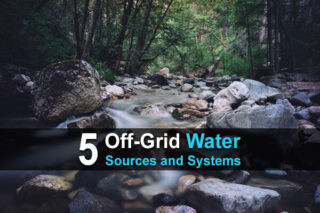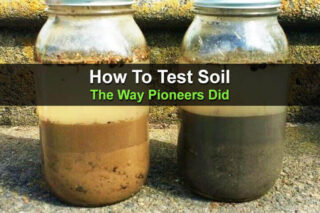Estimated reading time: 6 minutes
Amidst the chaos of phones that recognize your face, smart homes that recognize your voice, and drones that make you feel like eyes are everywhere, there is a rebellion that is cutting the cord. As the power of technology intrudes on our sapien lives, it would seem only rational that some would turn and run.
When I look at the swelling movements in outdoor adventure, fishing, hunting, and self-reliance, it’s clear that humanity is seeking a balance.
The leaders of this rebellion are the off-grid homesteaders. Those who have pulled their entire world away from the metaphorical socket of society and went searching for a new power source. While losing power takes some getting used to or some adaptation to renewable energies, losing running water is another story.
There are many ways that homesteaders can collect water. Some more obvious than others. There are also some technological tools that are pulling water from places we never thought possible. If you are planning on making a jump to the off-grid lifestyle, you must have a plan for water.
Want to save this post for later? Click Here to Pin It On Pinterest!
Water will play a large part in many essential activities on the homestead:
- Drinking
- Bathing
- Watering Plants
- Livestock
- Cleaning the Home and Tools
- Laundry
- Cooking
- Processing
We are going to look at 4 ways to gather water when living off grid.
1. Drilling A Well
The most conventional way to collect water when living off the grid is to drill a well. For most off-grid homesteaders, this is a necessity. You will have to have a well to survive unless you are on a body of water that provides you with a source you can purify and filter in bulk. I caution you, that is quite the undertaking.
While digging the well is but one step, you should also consider how you plan on getting that water to the surface. While some people will install a hand pump for their wells, I think it's worth getting an electric pump. There are very simple pumps that require hardly any power at all. You can upgrade as necessary.
Manage your well for efficiency and for convenience. This will be your primary water source in most cases.
2. Rainwater
One of the most popular water harvesting methods is that which falls from the sky. We have been collecting rainwater for eons, particularly in drier areas. In recent years we have seen rainwater in the news as some localities are looking to limit or even ban the collection of this water. It's outrageous to assume that the government should control the rainwater.
The most popular method of collecting rainwater is using a rain barrel that is hooked up to your gutter system. Most typical barrels hold 55 gallons of water which is a decent collection method. This is not your only option.
There are also much larger cisterns that can be buried underground and even patched into your home. These cisterns are also hooked up to your gutters. If you go this route, you better stay on top of cleaning those gutters or install some gutter guard. Make sure you don't make any of these rainwater harvesting mistakes.
There are also the 120-gallon cubes for water collection. I have seen these cubes placed on a stack of pallets with built-in eaves for water collection. These are phenomenal additions to gardens. These can be placed at the ends of large beds or rows for irrigation.
I have also seen large tarps with poles at each corner used to collect rainwater as well. While not as efficient as our cubes or cisterns they could be effective as a backup or as an addition.
3. Water Pump
We are going to utilize technology for the next couple water collection methods. While we spoke about a water pump for your well, this is not the only way you can use a pump to collect water. If your property has a water source, preferably a moving one like a river or creek, you could pump water directly from this location.
The use for this water should depend on the quality of the water source. If you have a stagnant or slow-moving stream, this water source might be better for watering plants or washing clothes than drinking. If you are downstream from a serious farming operation, you might do the same.
4. Humidity
Technology is changing the way we think about almost everything. Can you believe that we are facing a time where the humidity in the air can be harvested? Yes. One of the most innovative water harvesting technologies is called the Genny by Water-Gen. This product comes in three distinct unit for various water producing and carrying capacities.
These devices do require electricity but, as you know, it doesn’t require power from the grid. If you are gonna dedicate wind or solar to anything, I imagine it would be to your water source.
The smallest version of this device creates 30L of water per day or nearly 8 gallons. If you are talking about a family of four, the production from this unit will basically deal with your needs generously. It also has an 8-gallon holding tank.
The water collected will be sanitized and completely potable thanks to the unit, as well. This is something to consider for your off-grid water collection needs.
Conclusion
Water collection on an off-grid family scale requires methods that give you a serious bang for your buck. These methods are not the only ways to collect water, but they are the best methods for collecting lots of water.
In a survival situation, you may use things like a solar still which uses moisture from plants trapped under a tarp to condensate and drip into a collection vessel.
Another great one-person survival water collection method is to place plastic bags over a collection of leaves on a bush or small tree. In the sun these leaves will release moisture and be trapped in the bag.
While catchment methods like these will get you out of a pinch, when it comes to hydrating a family, you are going to need to yield much greater amounts of water. Utilize the methods above to assure you have a steady stream of potable water into your off-grid home.
Like this post? Don't Forget to Pin It On Pinterest!













i need help and im just a kid plus i’m doing a project why would i have to sign in
You don’t have to sign in to use this site.